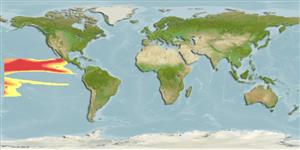>
Myctophiformes (Lanternfishes) >
Myctophidae (Lanternfishes) > Myctophinae
Etymology: Protomyctophum: Greek, pro = first, in front of + Greek, mykter, -eros = nose + Greek, ophys = serpent (Ref. 45335).
Eponymy: Vladimir Eduardovich Becker (1925–1995) was a Russian ichthyologist at the Institute of Oceanology, Moscow. [...] (Ref. 128868), visit book page.
Environment: milieu / climate zone / depth range / distribution range
Ecología
marino; rango de profundidad 0 - 2100 m (Ref. 58018). Tropical; 20°N -
Eastern Central Pacific: Hawaii.
Tamaño / Peso / Age
Maturity: Lm ? range ? - ? cm
Max length : 3.5 cm SL macho / no sexado; (Ref. 28981)
Mesopelagic (Ref. 58302).
Life cycle and mating behavior
Madurez | Reproducción | Puesta | Huevos | Fecundidad | Larva
Tinker, S.W., 1978. Fishes of Hawaii, a handbook of the marine fishes of Hawaii and the Central Pacific Ocean. Hawaiian Service Inc., Honolulu. 568 p. (Ref. 583)
IUCN Red List Status (Ref. 130435: Version 2024-1)
Threat to humans
Harmless
Human uses
Herramientas
Special reports
Download XML
Fuentes de Internet
Estimates based on models
Preferred temperature (Ref.
123201): 2.3 - 11.3, mean 2.9 °C (based on 13 cells).
Phylogenetic diversity index (Ref.
82804): PD
50 = 0.5000 [Uniqueness, from 0.5 = low to 2.0 = high].
Bayesian length-weight: a=0.01000 (0.00244 - 0.04107), b=3.04 (2.81 - 3.27), in cm total length, based on all LWR estimates for this body shape (Ref.
93245).
Nivel trófico (Ref.
69278): 3.2 ±0.5 se; based on size and trophs of closest relatives
Resiliencia (Ref.
120179): Alto, población duplicada en un tiempo mínimo inferior a 15 meses (Preliminary K or Fecundity.).
Fishing Vulnerability (Ref.
59153): Low vulnerability (10 of 100).
